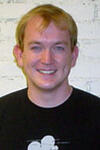Matthew Reed
Ph.D. 2013, Yale University
A quantum computer will use the properties of quantum physics to solve certain computational problems much faster than otherwise possible. One promising potential implementation is to use superconducting quantum bits in the circuit quantum electrodynamics (cQED) architecture. There, the low energy states of a nonlinear electronic oscillator are isolated and addressed as a qubit. These qubits are capacitively coupled to the modes of a microwave-frequency transmission line resonator which serves as a quantum communication bus. Microwave electrical pulses are applied to the resonator to manipulate or measure the qubit state. State control is calibrated using diagnostic sequences that expose systematic errors. Hybridization of the resonator with the qubit gives it a nonlinear response when driven strongly, useful for amplifying the measurement signal to enhance accuracy. Qubits coupled to the same bus may coherently interact with one another via the exchange of virtual photons. A two-qubit conditional phase gate mediated by this interaction can deterministically entangle its targets, and is used to generate two-qubit Bell states and three-qubit GHZ states. These three-qubit states are of particular interest because they redundantly encode quantum information. They are the basis of the quantum repetition code prototypical of more sophisticated schemes required for quantum computation. Using a three-qubit Toffoli gate, this code is demonstrated to autonomously correct either bit- or phase-flip errors. Despite observing the expected behavior, the overall fidelity is low because of decoherence. A superior implementation of cQED replaces the transmission-line resonator with a three-dimensional box mode, increasing lifetimes by an order of magnitude. In-situ qubit frequency control is enabled with control lines, which are used to fully characterize and control the system Hamiltonian.
